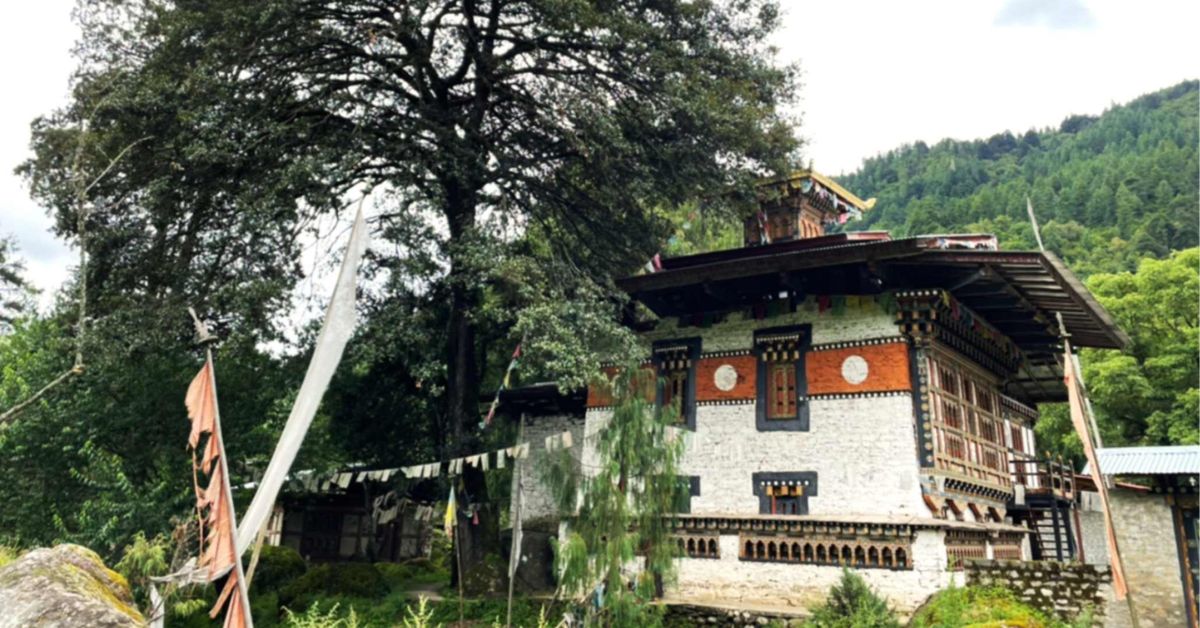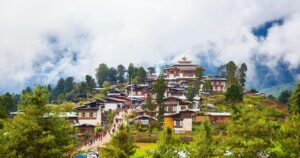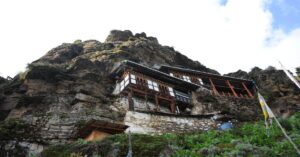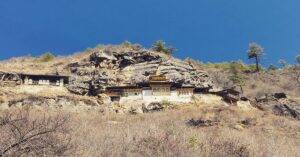Zhabjethang is a sacred plain where Guru Rinpoche and his consort Tashi Khyidren meditated and left their footprints in Chhokhor Toed under Bumthang Dzongkhag. A Lhakhang was built later in the 14th century by Terton Dorji Lingpa at the sacred site known as Zhabjeythang Lhakhang.
The Lhakhang is a two-story house but is distinguished by a red band of Kheymar. Zhabjethang Lhakhang is located at Zhabjethang village under Chhoekhor gewog an elevation of around 2800 meters above sea level.
However, you are cautioned not to confuse Zhabjithang Lhakhang with Zhabje Lhakhang at Dangchu Gewog under Wangdue Phodrang Dzongkhag.
How to Reach Zhabjethang
The Zhabjethang Lhakhang is located above the settlement of Zhabthang in the upper Chhoekhor Valley near the Chhoekhor Toe Primary School, with access to a motor road passing not far from the site. It is around twenty-two kilometers from Chamkhar town, which is above the farm road connecting to Nasphel village. One can easily reach the sacred site by road. It is 15 kilometers from Jakar Dzong.
Sacred Relics to See Bumthang Zhabjethang
- Footprint of Guru Rinpoche;
- The footprint of Menmo Tashi Khyidren;
- A throne (Zhug Thri) of Guru Rinpoche;
- A tree believed to be the Guru’s walking stick;
- The Statues of Guru Tsokhorsum (Guru and two consorts- usually Yeshey Tshogyel and Mendarawa);
- A place where Lama Drukpa Kuenley and Terton Pema Lingpa debated by showing their attainment of spiritual powers;
- The sacred footprints of Trulku Chogden Gonpo;
- A firefighting competition at the Chaw Dhugpa festival.
Also Read: Guru Rinpoche in Bhutan: His Visits to Bhutan and Sacred Sites
Historical Significance of Zhabjeythang
According to the history of Zhabjethang, Guru Rinpoche is said to have manifested into a wrathful form called “fire garland” to subdue the demon Gajed Zhonu. During the pacification process, the demon’s body, limbs, and entrails were entombed in the rock, and Guru stepped on it, leaving imprints of his feet on the rock.
Another source said that Zhabjethang was once said to be a lake turned into a plain by the miraculous power of Guru Rimpoche, who was destined to bless the place as one of his meditation hermitages by throwing a stone at the lake. After turning the lake into the plain, Guru Padmasambhava is said to have meditated at Zhabjethang and left various imprints in the rocks, including his footprint, which is a revered relic. As a result, the area became known as Zhabjethang or the “Plain of Footprints.”
In the 14th century, Terton Dorji Lingpa visited Zhabjethang and founded a small temple in this sacred place. Since then, Zhabjithang Goenpa has been the seat of Terten Dorji Lingpa. The Terton has also left behind some of his Termas in the temple. Trulku Chogden Gonpo, an immediate incarnation of Terton Dorji Lingpa, renovated the Lhakhang and spent time there in the 15th century.
Gyalwa Longchen Rabjam also visited this sacred place. Later, his immediate incarnation, Terton Pema Lingpa, also blessed the place. Choje Drukpa Kuenley also visited the holy plain of Zhabethang while visiting Bumthang.
Description of Zhabjeythang
A rock carrying the footprints of Guru Rinpoche and his consort Menmo Tashi Khyidren, the daughter of King Sindhu Raja of Bumthang, whose life was saved by Guru Rinpoche, can be found on the bottom floor in a small chamber of Zhabjethang Goempa. Zhabjethang is also believed to have 108 footprints of Guru Rinpoche around the sacred site of Zhabjethang.
Above the Lhakhang is Guru Rinpoche’s throne (Zhugthri). A tree said to be the Guru’s walking stick can also be seen there. In the open ground, there are still traces of a knife being recovered while subduing a demon disguised as a black yak, probably used to chop the head and skin.
There is a place where Lama Drukpa Kuenley and Terton Pema Lingpa debated by showing their attainment of spiritual powers. A little far away from this sacred place are the footprints of Trulku Chogden Gonpo.
Dorling Dung Karma Lhawang, once the owner of Zhabjethang Lhakhang, offered Ranjung Rasarpani (the self-created image of Avalokiteshvara) to Trongsa Dzong, which he brought from Tibet as per the recommendation of Desi Jigme Namgyel. As compensation, the governor of Trongsa offered land in the temple’s name. Today, we can see Rangjung Rasarpani inside Dechog Lhakhang of Trongsa Dzong.
Zhabjethang Lhakhang
Zhabjethang Lhakhang was first built by Terton Dorji Lingpa in the 14th century. Later in the 15th century, Trulku Chogden Gonpo, the reincarnation of Terton Dorji Lingpa, renovated the temple once. In the 20th century, the Lhakhang was renovated and extended into a two-story building by Trongsa Tshogpon Dolong.
The Lhakhang’s boundary is demarcated by a low-height stone masonry wall with a small entrance gate. The Lhakhang looks like a traditional Bhutanese house when viewed from one elevation, but with the red band of Kheymar and prayer wheels surrounding 3/4th of the Lhakhang, one can identify it as a Lhakhang.
The Lhakhang’s main wall is made up of stone masonry with mud mortar. The doors, the windows, and the roof structural components are made up of timber. The Lhakhang has three layers of roof. A Jabzhi roof with Sertog on the first layer, a Jamthok roof on the second layer, and a gabled roof on the third layer as the main roof covering. On the front and rear elevations, one can also notice the Chenkhep roof being mounted on top of Drey-Zhu Rabsel as additional protection for Rabsel.
The unique feature of this Lhakhang is the intricate painting on Drey-Zhu Rabsel, painted mostly in golden color with traditional motifs, which makes it one of the prominent eye-catching features on the elevation of Lhakhang.
Ground Floor
On the ground floor, it has a small chamber containing a rock bearing the footprints of Guru Rinpoche and his consort Menmo Tashi Kheudren. The L-shaped room next to it is a ritual room with a dark interior due to the windows being blocked by later additions of prayer wheels surrounding the Lhakhang from the outside. Adjacent to the ground floor, there is an extension of Mani Dungkhor built on a higher plinth level. The interiors of this extension have paintings of Lord Buddha and Zhabdrung Ngawang Namgyel.
First Floor
The staircase outside, right next to the ground-floor door, leads to the first floor. The staircase leads to a lobby area and a Torkhang made up of an ekra wall. Just next to the lobby is the main altar room. The main relics of the Zhabjeythang Lhakhang are the statues of Guru Tsokhor Sum, sculptured by Terton Ugyen Zangpo. They are similar to those in Chakhar Lhakhang. Inside the main altar room, one window has been blocked from the inside to make it into a solid wall and to decorate with a fine painting of the 12th-century Tibetan saint Milarepa, probably done in the late 19th century.
The temple is owned by the descendants of Terton Dorji Lingpa, as it is a private temple handed down from one generation to another. Currently, a caretaker looks after the Zhabjethang Lhakhang and performs the community’s rituals.
Best Time to Visit Bumthang Zhabjethang Lhakhang
You can visit at any time of the year. Bumthang’s Zhabjethang village is one of the villages chosen for homestays. So, while on your trip to one of the holiest sites, you can stay in a homestay. If time allows, you can also hike to Wangchuck Centennial National Park or visit the GNH Center, which is close. However, festival lovers should see on the 29th day of the 10th month of the Bhutanese calendar, when the Chaw Dhugpa Festival is held, during which residents of Zhabjethang and neighboring villages of Chhoekhor-Toe compete in a firefighting competition. Religious mask dances are also performed at the festival.
You can contact the site manager, Kuenzang Dorji, at 17291727. You can visit the major pilgrimage sites of Bumthang with the Bhutan Pilgrimage Package.
Enjoyed reading this blog?




